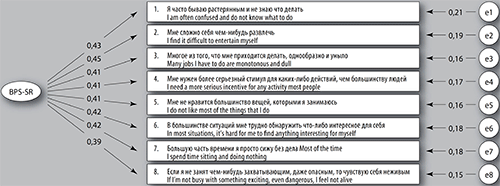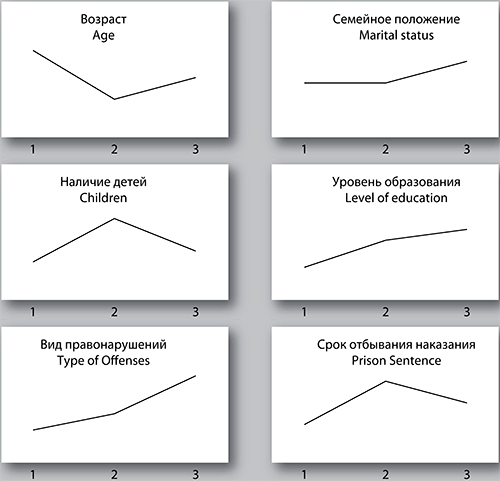Measurement of boredom proneness: Russian adaptation of the BPS-SR
Recieved: 02/06/2020
Accepted: 02/15/2020
Published: 03/31/2020
Pages: 40-49
DOI: 10.11621/npj.2020.0104
Keywords: boredom proneness; apathy; hopelessness; loneliness; depression
Available online: 31.03.2020
Zolotareva Alena A. (2020). Measurement of boredom proneness: Russian adaptation of the BPS-SR. National Psychological Journal, (1) , 40-49. https://doi.org/10.11621/npj.2020.0104
Copied to Clipboard
CopyAbstract
Background. The BPS-SR (Boredom Proneness Scale-Short Form) is a brief and most efficacious version of the famous Boredom Proneness Scale developed by R. Farmer and N. Sundberg (Struk, 2017).
Objective. This study is aimed to adapt the Russian BPS-SR version.
Design. Psychometric indicators of the Russian BPS-SR version have been assessed on the sample of males (N=151) serving sentences in prison.
Findings. The factor structure of the BPS-SR, estimated using exploratory and confirmatory factor analyses, has demonstrated the scale homogeneity and thus confirmed the original BPS-SR authors’ hypothesis suggesting the advantage of the scale comprising only direct test items. The BPS-SR reliability (α-Cronbach=0.86) and validity indicators also have confirmed the psychometric adequacy of the Russian scale adaptation. The boredom proneness has proven to be positively associated with apathy, hopelessness, loneliness and male depressive syndrome, which allows considering it a possible factor in psychological maladjustment as an adult. The social and demographic characteristics evaluation performed using the one-way analysis of variance ANOVA has showed that age, marital status, having or not having children, offense type and sentence term do not significantly contribute to the boredom proneness, while the BPS-SR indicators depend directly on the respondents’ education. The respondents having obtained the higher and specialized secondary education have proven to be less prone to boredom than respondents having the basic secondary or full secondary education.
Conclusion. The conclusion infers that the adapted BPS-SR can actually be considered a psychometrically reasonable means to diagnose boredom proneness in Russianspeaking respondents.
Table 1. Factor structure of the Russian BPS-SR version (based on EFA results)
|
Questionnaire Statements |
Factor load |
|
|
1. |
I am often confused and do not know what to do. |
0.72 |
|
2. |
It’s hard for me to entertain myself with anything. |
0.46 |
|
3. |
Many jobs I have to do are monotonous and dull. |
0.43 |
|
4. |
I need a more serious incentive for any action than most people. |
0.46 |
|
5. |
I do not like most of the things that I do. |
0.48 |
|
6. |
In most situations, it’s hard for me to find anything interesting for myself. |
0.55 |
|
7. |
Most of the time I spend time sitting and doing nothing |
0.47 |
|
8. |
If I’m not busy with something exciting, even dangerous, I feel not alive. |
0.55 |
Table 2. Indicators of convergent validity of the Russian BPS-SR version
|
Variables |
Boredom Proneness |
|
|
1. |
Apathy |
0.32 (p<0.001) |
|
2. |
Experiencing hopelessness |
0.41 (p<0.001) |
|
3. |
The experience of loneliness |
0.43 (p<0.001) |
|
4. |
Male Depressive Syndrome |
0.42 (p<0.001) |

Fig 1. Factor structure of the Russian BPS-SR e version (based on CFA results)

Fig 2. Influence of socio-demographic characteristics on boredom proneness according to the Russian BPS-SR version
NB: Age: 1 = “respondents under 30 years old.” 2 = «respondents aged 30 to 40 years.» 3 = «respondents over 40 years old.» Marital status: 1 = “single”. 2 = «married.» 3 = «divorced.» Children: 1 = «no children.» 2 = «there is 1 child.» 3 = «there are 2 or more children.» Level of education: 1 = «incomplete secondary education or general secondary education.» 2 = “secondary specialized education”. 3 = «higher education.» Type of offense: 1 = “economic crimes”. 2 = «crimes against public health and public morality.» 3 = «crimes against the person.» Prison sentence: 1 = «less than 1 year.» 2 = «from 1 to 10 years.» 3 = «over 10 years.»
Acknowledgments
The article was prepared within the framework of the Basic Research Program at the National Research University Higher School of Economics (HSE) and supported within the framework of a subsidy by the Russian Academic Excellence Project ‘5-100.
References
Acee, T.W., Kim, H., Kim, H.J., Kim, J., Hsiang-Ning, R.C., Kim, M., Cho, Y., & Wicker, F.W. (2010). Academic boredom in under-and over-challenging situations. Contemporary Educational Psychology, 35(1), 17–27. doi: 10/1016/j.cedpsych.2009.08.002
Ahmed, S.M.S. (1990). Psychometric properties of the Boredom Proneness Scale. Perceptual and Motor Skills, 71(3), 963–966. doi: 10.2466/ pms.1990.71.3.963
Al-Shara, I. (2015). Learning and teaching between enjoyment and boredom as realized by the students: A survey from the educational field. European Scientific Journal, 11(19), 146–168.
Avtonomov D.A. (2014). Male depressive syndrome. [Nezavisimost’ lichnosti], 2, 8–11.
Beck, A.T., & Steer, R.A. (1993). Beck Hopelessness Scale (BHS) manual. Pearson: San Antonio.
Conroy, R.M., Golden, J., Jeffares, I., O’Neill, D., & McGee, H. Boredom-proneness, loneliness, social engagement and depression and their association with cognitive function in older people: A population study. Psychology, Health and Medicine, 15(4), 463–473. doi: 10.1080/13548506.2010.487103
Craparo, G., Faraci, P., Fasciano, S., Carrubba, S., & Gori, A. (2013). A factor analytic study of the Boredom Proneness Scale (BPS). Clinical Neuropsychiatry: Journal of Treatment Evaluation, 10(3–4), 164–170. doi: 10.1207/s15327752jpa5501&2_11
Daschmann, E.C., Goetz, T., & Stupnisky, R.H. (2011). Testing the predictors of boredom at school: Development and validation of the precursors to boredom scales. British Journal of Educational Psychology, 81(Pt3), 421–440. doi: 0.1348/000709910x526038
Dursun, P., & Tezer, E. (2013). Turkish adaptation of the Boredom Proneness Scale-Short Form. Procedia – Social and Behavioral Sciences, 84, 1550–1554. doi: 10.1016/j.sbspro.2013.06.786
Fahlman, S.A., Mercer-Lynn, K.B., Flora, D.B., & Eastwood, J.D. (2013). Development and validation of the multidimensional state boredom scale. Assessment, 20(1), 68–85. doi: 10.1177/1073191111421303
Farmer, R., & Sundberg, N.D. (1986). Boredom proneness: The development and correlates of a new scale. Journal of Personality Assessment, 50(1), 4–17. doi: 10.1207/s15327752jpa5001_2
Gana, K., & Akremi, M. (1998). L’échelle de Disposition à l’Ennui (EDE): Adaptation française et validation du Boredom Proneness Scale (BP). L’Année Psychologique, 98(3), 429–450 (in French). doi: 10.3406/psy.1998.28576
Gannon, T.A., Ciardha, C.O., Barnoux, M.F., Tyler, N., Mozova, K., & Alleyne, E.K. (2013). Male imprisoned firesetters have different characteristics than other imprisoned offenders and require specialist treatment. Psychiatry, 76(4), 349–364. doi: 10.1521/psyc.2013.76.4.349
Goldber, Y.K., Eastwood, J.D., Laguardia, J., & Danckert, J. (2011). Boredom: An emotional experience distinct from apathy, anhedonia, or depression. Journal of Social and Clinical Psychology, 30(6), 647–666. doi: 10.1521/jscp.2011.30.6.647
Gorbatkov A.A. (2002). The scale of hope and hopelessness for adolescents: some aspects of validity. [Psikhologicheskaya nauka I ibrazovanie], 3, 89–103.
Hamilton, J.A., Haier, R.J., & Buchsbaum, M.S. (1984). Intrinsic enjoyment and boredom coping scales: Validation with personality, evoked potential, and attention measures. Personality and Individual Differences, 5(2), 183-193. doi: 10.1016/0191-8869(84)90050-3
Harasymchuk, C., & Fehr, B. (2012). Development of a prototype-based measure of relational boredom. Personal Relationships, 19(1), 162–181. doi: 10.1111/j.1475-6811.2011.01346.x
Hu, L., & Bentler, P.M. (1999). Cutoff criteria for fit indexes in covariance structure analysis: Conventional criteria versus new alternatives. Structural Equation Modeling, 6, 1–55. doi: 10.1080/10705519909540118
Iso-Ahola, S.E., & Weissinger, E. (1990). Perceptions of boredom in leisure: Conceptualization reliability, and validity of the Leisure Boredom Scale. Journal of Leisure Research, 22(1), 1–17. doi: 10.1080/00222216.1990.11969811
Koç, E., Ekş, H., & Demirci, İ. (2018). The psychometric properties of the Turkish form of Boredom Proneness Scale-Short Form (BPS-SR). 1st International Congress on Seeking New Perspectives in Education, 11–12 May, Istanbul, Turkey.
Krach, S.K., McCreery, M.P., & Guerard, J. (2017). Cultural-linguistic test adaptations: Guidelines for selection, alteration, use, and review. School Psychology International, 38(1), 3–21. doi: 10.1177/0143034316684672
Lee, T.W. (1986). Toward the development and validation of a measure of job boredom. Manhattan College Journal of Business, 15, 22–28.
Liu, Y., Chen, J.-z., Song, L.-t., Zhao, Y., Yang, X.-l., Zhang, P., & Zhou, H. Reliability and validity of Chinese version of Boredom Proneness Scale. Chinese Journal of Clinical Psychology, 22(1), 74–77 (in Chinese).
Loewenthal, K.M. (2001). An introduction to psychological tests and scales (2 ed.). Hove, UK: Psychology Press.
Mercer, K.B., & Eastwood, J.D. (2010). Is boredom associated with problem gambling behaviour? It depends of what you mean by “boredom”. International Gambling Studies, 10(1), 91–104. doi: 10.1080/14459791003754414
McIntosh, E.G. (2006). Sex differences in boredom proneness. Psychological Reports, 98(3), 625–626. doi: 10.2466/pr0.98.3.625-626
Nett, U.E., Goetz,T., & Daniels, L.M. (2010). What to do when feeling bored: Student strategies for coping with boredom. Learning and Individual Differences, 20(6), 626–638. doi: 10.1016/j.lindif.2010.09.004
Osin E.N., & Leontiev D.A. (2013). Differential questionnaire of the experience of loneliness: structure and properties. [Psikhologiya. Zhurnal Vysshey shkoly ekonomiki], 10(1), 55–81.
Pekrun, R., Goetz, T., Titz, W., & Perry, R.P. (2002). Academic emotions in students’ self-regulated learning and achievement: A program of qualitative and quantitative research. Educational Psychologist, 37(2), 91–105. doi: 10.1207/S15326985EP3702_4
Piotrowski, C. (2013). Boredom research: An analysis of topical domain and historical trends. Journal of Instructional Psychology, 40(2), 50–52.
Posokhova S.T., & Rohina E.V. (2015). Predisposition to boredom as a sign of psychological vulnerability of a person. [Vestnik SPbGU] Series 16, 4, 46–55.
Ragheb, M.G., & Merydith, S.P. (2001). Development and validation of a unidimensional scale measuring free time boredom. Leisure Studies, 20(1), 41–59. doi: 10.1080/02614360122569
Reijseger, G., Schaufeli, W.B., Peeters, M.C.W., Taris, T.W., van Beek, I., & Ouweneel, E. (2013). Watching the paint dry at work: Psychometric examination of the Dutch Boredom Scale. Anxiety, Stress & Coping: An International Journal, 26(5), 508–525. doi: 10.1080/10615806.2012.720676
Rocheleau, A.M.K. (2013). An empirical exploration of the “pains of imprisonment” and the level of prison misconduct and violence. Criminal Justice Review, 38(3), 354–374. doi: 10.1177/0734016813494764
Sommers, J., & Vodanovich, S.J. (2000). Boredom proneness: Its relationship to psychological- and physical-health symptoms. Journal of Clinical Psychology, 56(1), 149–55. doi: 10.1002/(SICI)1097-4679(200001)56:1<149::AID-JCLP14>3.0.CO;2-Y
Struk, A.A., Carriere, J.S., Cheyne, J.A., & Danckert, J. (2017). A Short Boredom Proneness Scale: Development and psychometric properties. Assessment, 24(3), 346–359. doi: 10.1177/1073191115609996
Studak, C.M., & Workman, J.E. (2004). Fashion groups, gender, and boredom proneness. International Journal of Consumer Studies, 28(1), 66–74. doi: 10.1111/j.1470-6431.2004.00335.x
Sykes, G.M. (1958). The society of captives. Princeton, NJ: Princeton University Press.
Todman M. (2013). The dimensions of state boredom: Frequency, duration, unpleasantness, consequences and causal attributions. Educational Research International, 1(1), 32–40
van Tilburg, W.A.P., & Igou, E.R. (2012). On boredom: Lack of challenge and meaning as distinct boredom experiences. Motivation and Emotion, 36(2), 181–194. doi: 10.1007/s11031-011-9234-9
Vodanovich, S.J. (2003). Psychometric measures of boredom: A review of the literature. The Journal of Psychology, 137(6), 569–595. doi: 10.1080/00223980309600636
Vodanovich, S., & Kass, S.J. (1990a). A factor analytic study of the Boredom Proneness Scale. Journal of Personality Assessment, 55(1), 115–123. doi: 10.1207/s15327752jpa5501&2_11
Vodanovich, S., & Kass, S.J. (1990b). Age and gender differences in boredom proneness. Journal of social behavior and personality, 5(4), 297–307.
Vodanovich, S.J., Kass, S.J., Andrasik, F., Gerber, W.-D., Niederberger, U., & Breaux, C. (2011). Culture and gender differences in boredom proneness. North American Journal of Psychology, 13(2), 221–230. doi: 10.1207/s15327752jpa8503_05
Vodanovich, S.J., Wallace, J.C., Kass, S.J. (2005). A confirmatory approach to the factor structure of the Boredom Proneness Scale: Evidence for a two-factor short form. Journal of Personality Assessment, 85(3), 295–303.
Vodanovich, S., & Watt, J. (2015). Self-report measures of boredom: An updated review of the literature. The Journal of Psychology Interdisciplinary and Applied, 150(2), 1–33. doi: 10.1080/00223980.2015.1074531
Watt, J.D., & Ewing, J.E. (1996). Toward the development and validation of a measure of sexual boredom. Journal of Sex Research, 33(1), 57–66. doi: 10.1080/00224499609551815
Zierau, F., Bille, A., Rutz, W., & Bech, P. (2002). The Gotland Male Depression Scale: A validity study in patients with alcohol use disorder. Nordic Journal of Psychiatry, 56(4), 265–271. doi: 10.1080/08039480260242750
Zolotareva A.A. (2017). Development and testing of a new psychological apathy scale. [Materialy 5oy Vserossiyskoy nauchno-prakticheskoy konferentsii «Aktual’nye voprosy psikhologii zdorov’ya i psikhosomaticheskoy distsipliny» (g. Makhachkala, 24 noyabrya 2017 g.)]. Makhachkala: Dagestanskiy gosudarstvennyy meditsinskiy universitet, 86–91.
Zuckerman, M. (1979). Sensation seeking: Beyond the optimal level of arousal. Hillsdale, NJ: Erlbaum.
Zolotareva Alena A.. Measurement of boredom proneness: Russian adaptation of the BPS-SR. // National Psychological Journal 2020. 1. Pages40-49. doi: 10.11621/npj.2020.0104
Copied to Clipboard
Copy

